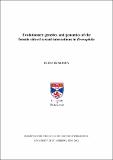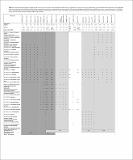Files in this item
Evolutionary genetics and genomics of the female side of sexual interactions in Drosophila
Item metadata
| dc.contributor.advisor | Ritchie, Michael G. | |
| dc.contributor.author | Immonen, Elina | |
| dc.coverage.spatial | 179 | en_US |
| dc.date.accessioned | 2012-10-25T09:19:31Z | |
| dc.date.available | 2012-10-25T09:19:31Z | |
| dc.date.issued | 2012-11-30 | |
| dc.identifier | uk.bl.ethos.558134 | |
| dc.identifier.uri | https://hdl.handle.net/10023/3224 | |
| dc.description.abstract | Sexual interactions play an important role in generating sexual selection and antagonistic co-evolution. These forces can shape differences between the sexes, but also have the potential to generate population divergence and contribute to speciation. The aim in this thesis was to provide new insights into the genes involved in different stages of female sexual interactions, using Drosophila as a model system. In chapter 2 I tested whether a candidate gene (period) that influences species-specific rhythmic characteristics in male courtship song in D. melanogaster also has a pleiotropic effect on female song preference. Using mutant and transgenic strains I found support for this. In chapter 3 I examined further how females respond to the song at the level of gene expression, using microarrays. Expression profiles revealed modest changes in transcripts abundance overall, which were dominated by antennal olfactory genes, neuropeptide encoding genes and immunity genes. Many of these have previously been found to respond to mating. In chapter 4 I therefore studied further two of these genes, TurandotM and TurandotC and their role in female post-mating fitness. Using RNA interference I found that knocking down these genes influenced immediate fecundity. In chapter 5 I focused on analysing post-mating gene expression patterns in relation to sexual selection in D. pseudoobscura using microarrays. I explored the consequences of experimental variation in female promiscuity on gene expression divergence as a whole, and in response to mating. I found large-scale expression divergence between monandrous and polyandrous females after 100 generations of experimental evolution. Experimental polyandry increased the expression of genes that show female-biased expression in wild-type individuals and decreased male- biased gene expression. Females experiencing no sexual selection showed the opposite pattern. Out of the genes affected by mating, the majority showed increased expression in polyandrous compared to monandrous females, with enrichment e.g. in oogenesis-related genes. | en_US |
| dc.language.iso | en | en_US |
| dc.publisher | University of St Andrews | |
| dc.subject | Sexual selection | en_US |
| dc.subject | Gene expression | en_US |
| dc.subject | Speciation | en_US |
| dc.subject | Experimental evolution | en_US |
| dc.subject.lcc | QL537.D76I6 | |
| dc.subject.lcsh | Drosophila melanogaster--Genetics | en_US |
| dc.subject.lcsh | Sexual selection in animals | en_US |
| dc.subject.lcsh | Gene expression | en_US |
| dc.subject.lcsh | Species diversity | en_US |
| dc.subject.lcsh | Evolutionary genetics | en_US |
| dc.title | Evolutionary genetics and genomics of the female side of sexual interactions in Drosophila | en_US |
| dc.type | Thesis | en_US |
| dc.type.qualificationlevel | Doctoral | en_US |
| dc.type.qualificationname | PhD Doctor of Philosophy | en_US |
| dc.publisher.institution | The University of St Andrews | en_US |
This item appears in the following Collection(s)
Items in the St Andrews Research Repository are protected by copyright, with all rights reserved, unless otherwise indicated.


